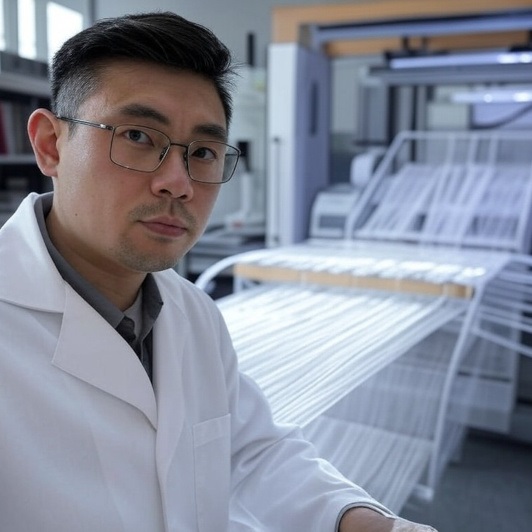
London-based biomaterials company Modern Synthesis has unveiled a new class of nonwoven materials derived from ‘bacterial nanocellulose’.
Sustainable Alternative To Other Materials
These innovative textiles can be made to replace everything from plastic films to leathers, thereby offering a sustainable alternative to some of the fashion and automotive industries’ most environmentally damaging materials.
Who Is Modern Synthesis?
Founded by former Adidas designer Jen Keane and biomaterials specialist Ben Reeve, Modern Synthesis is an emerging leader in the development of next-generation textiles that move beyond petrochemical and animal-derived materials. The company, headquartered in London, is focused on harnessing bacterial nanocellulose to create a versatile range of fabrics that are not only high-performance but also fully biodegradable.
Keane, now CEO, came into the spotlight in 2018 when she successfully ‘grew’ a shoe using bacteria, demonstrating the potential of biofabrication. However, she believes the true potential lies not in shaping materials as they grow, but in using bacterial cellulose as a foundational fibre that can be manipulated and scaled like traditional textiles.
What is this New Material and Why is it Significant?
Modern Synthesis’ material is primarily made from bacterial nanocellulose, i.e. a natural fibre that is eight times stronger than steel when produced at the nanoscale (materials measured in nanometres, typically less than 100 nm). Unlike plant-based cellulose (which requires intensive farming, land, and water), bacterial nanocellulose is cultivated through fermentation. This makes it a highly efficient and sustainable alternative.
What sets Modern Synthesis apart is its proprietary process, which integrates bacterial nanocellulose with a woven or knitted textile scaffold. This method allows the final material to be fine-tuned for different textures and mechanical properties, making it possible to replace synthetic leathers, coated fabrics, and even high-performance technical textiles.
Unlike most bio-based leather alternatives (which often rely on synthetic binders to achieve durability), Modern Synthesis’ process is entirely free from petrochemicals. The result is a fully biodegradable material that behaves much like conventional textiles but with a significantly reduced environmental footprint.
How is the Material Made?
The production process is an advanced form of microbial fermentation. The company uses a strain of bacteria known as Komagataeibacter rhaeticus, which naturally produces nanocellulose when fed with agricultural sugars. As the bacteria grow, they deposit nanocellulose fibres around a specially designed yarn scaffold, resulting in a unique, nonwoven textile structure.
This controlled approach allows for the fine-tuning of material properties, such as flexibility, strength, and texture, by adjusting the bacterial growth conditions and the composition of the scaffold. Unlike synthetic textiles that require chemical treatments to achieve similar properties, Modern Synthesis’ materials develop these characteristics organically.
Environmental and Industry Implications
The implications for both the fashion industry and the wider materials market could be vast. For example, leather and synthetic textiles, such as polyurethane-based vegan leathers, are major contributors to greenhouse gas emissions, plastic pollution, and deforestation. The carbon footprint of Modern Synthesis’ bacterial nanocellulose-based textiles is expected to be significantly lower than that of both traditional leather and synthetic alternatives.
Water usage is another key area of impact. Traditional leather production requires thousands of litres of water per square metre, whereas bacterial nanocellulose fermentation uses a fraction of that amount. Also, Modern Synthesis’ material does not involve toxic tanning chemicals, further reducing its environmental impact.
For businesses, this innovation could offer a way to meet growing consumer demand for sustainability without sacrificing quality or performance. Luxury brands and sportswear companies have already shown interest, with Danish fashion house Ganni collaborating with Modern Synthesis in 2023 to create a handbag made entirely without petrochemicals.
Potential Applications
Beyond fashion, Modern Synthesis’ materials have potential applications in:
– Footwear. As a lightweight, durable replacement for leather and synthetic uppers.
– Automotive interiors. The material’s high-temperature resistance and durability make it an attractive option for dashboards and upholstery.
– Smart textiles. The company is exploring how nanocellulose can be integrated with electronics for wearable technology.
Keane has highlighted the versatility of the material, stating, “Cellulosic materials don’t melt like synthetics do. If you think about car dashboards, how they start to warp when left in the sun too long—our materials won’t do that.”
Challenges and Limitations
While Modern Synthesis’ technology seems promising, there are still many hurdles to overcome before widespread adoption. For example, the company recognises that scaling production to meet industrial demand remains a major challenge. With this in mind, the company is currently working to increase production at its pilot facility fivefold, but larger-scale manufacturing will require further investment and infrastructure.
Another challenge is recyclability. While the material is biodegradable, ensuring it is also recyclable without compromising its durability remains a key focus. Many bio-based materials require additional treatments that can hinder their ability to be repurposed at the end of their life cycle. Modern Synthesis is understood to be actively working with “green chemistries” to develop formulations that balance performance with circularity.
Who Else is Developing Similar Materials?
Modern Synthesis is actually part of a growing movement towards microbial-based textiles. Other players exploring bacterial nanocellulose include:
– MycoWorks, which specialises in mushroom-derived mycelium leather.
– Bolt Threads. Developed Mylo, another mycelium-based leather alternative.
– Ananas Anam, the creators of Piñatex, a plant-based leather alternative derived from pineapple leaves.
However, most of these alternatives still require synthetic binders, whereas Modern Synthesis’ approach stands out for being entirely bio-based and customisable at the nanoscale.
What Does This Mean For Your Organisation?
Modern Synthesis’ bacterial nanocellulose-based textiles could be an important advancement in the quest for sustainable materials. By leveraging microbial fermentation to create high-performance, biodegradable fabrics, the company is offering an alternative that challenges both traditional leather and synthetic textiles on environmental grounds. Unlike many bio-based alternatives that still rely on petrochemical additives, this new class of material is not only renewable but also fully biodegradable, making it a compelling solution for industries seeking to reduce their ecological footprint.
However, while the potential is undeniable, challenges remain. Scaling up production to meet commercial demand is a critical hurdle, as is ensuring the material can be seamlessly integrated into existing supply chains. Also, achieving true circularity (i.e. where the material is not just biodegradable but also efficiently recyclable) will be essential in determining its long-term impact. Modern Synthesis appears to be actively addressing these concerns, but success will likely depend on continued innovation and investment.
What appears to set Modern Synthesis apart is not just its scientific approach but its vision for redefining how materials are made. By collaborating with major fashion brands and exploring applications beyond apparel, the company is positioning its technology as a viable replacement for some of the most environmentally damaging materials in use today. If production challenges can be overcome, bacterial nanocellulose textiles could play a key role in reducing reliance on fossil fuels, lowering carbon emissions, and transforming industries that have long been dependent on resource-intensive materials.
This innovation could, therefore, offer a promising glimpse into the future of sustainable manufacturing. While it may take time to achieve widespread adoption, the foundations are being laid for a possible material revolution and one that moves beyond extraction and towards biofabrication. If Modern Synthesis and others in the field can bridge the gap between laboratory breakthroughs and large-scale industry use, bacterial nanocellulose textiles could become a defining material of the sustainable era.




